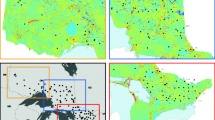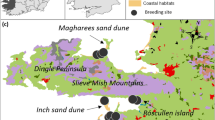Abstract
Connectivity, or the integration of populations into a single demographic unit, is an often desired, but largely untested aspect of wildlife corridors. Using a corridor system that was established at least 85 years prior, we investigated the extent of connectivity provided. This was undertaken using a combined ecological and genetic approach with connectivity estimated by gene flow. Vegetation within the corridor was found to be comparable in physical structure and species composition to that within the connected patches and the two target species (Melomys cervinipes and Uromys caudimaculatus) were shown to occur along the corridor but not within the surrounding matrix. These factors indicated that the corridor was suitable for use as a model system. The population structure (weights of individuals, sex ratios and the percentage of juveniles) of both species were also similar within the corridor and the connected patches suggesting that the corridor provided the resources necessary to sustain breeding populations along its length. Despite this, populations in patches linked by the corridor were found to show the same significant levels of genetic differentiation as those in isolated habitats. M. cervinipes, but not U. caudimaculatus, also showed population differentiation within the continuous habitat. Although based on only one corridor system, these results clearly demonstrate that connectivity between connected populations will not always be achieved by the construction or retention of a corridor and that connectivity cannot be inferred solely from the presence of individuals, or breeding populations, within the corridor.
Similar content being viewed by others
References
J. Aars R.A. Ims H-P. Liu M. Mulvey M.H. Smith (1998) ArticleTitleBank voles in linear habitats show restricted gene flow as revealed by mitochondrial DNA (mtDNA) Mol. Ecol. 7 1383–1389 Occurrence Handle9787447 Occurrence Handle10.1046/j.1365-294x.1998.00487.x Occurrence Handle1:STN:280:DyaK1M%2FgtlOitw%3D%3D
W. Amos J. Harwood (1988) ArticleTitleFactors affecting levels of genetic diversity in natural populations Philos. Trans. Roy. Soc. Lond. B 353 177–186 Occurrence Handle10.1098/rstb.1998.0200
Baudry J. and Merriam G. 1988. Connectivity and connectedness: functional vs structural patterns in landscapes. In: Schreiber K.F. (ed.), Connectivity in Landscape Ecology. Proceedings of the 2nd seminar of the International Association for Landscape Ecology, Munsterpp. 23–28.
R.O. Bierregaard SuffixJr. W.F. Laurance J. W. Sites A.J. Lynam R.K. Didham M. Anderson C. Gascon M.D. Tocher A.P. Smith V.M. Viana T.E. Lovejoy K.E. Sieving E.A. Kramer C. Restrepo C. Moritz (1997) Key priorities for the study of fragmented tropical ecosystems W.F. Laurance R.O. Bierregaard (Eds) Tropical Forest Remnants. Ecology, Management and Conservation of Fragmented Communities The University of Chicago Press Chicago 515–525
A.F. Bennett (1990) ArticleTitleHabitat corridors and the conservation of small mammals in a fragmented forest environment Landscape Ecol. 4 109–122 Occurrence Handle10.1007/BF00132855
A.F. Bennett (1999) Linkages in the Landscape. The Role of Corridors and Connectivity in Wildlife Conservation IUCN Gland, Switzerland
E.G. Bolen W.L. Robinson (1995) Wildlife Ecology and Management Prentice-Hall New Jersey
D.T. Bolger T.A. Scott J.T. Rotenberry (2001) ArticleTitleUse of corridor-like landscape structures by bird and small mammal species Biol. Conserv. 102 213–224 Occurrence Handle10.1016/S0006-3207(01)00028-3
M.A. Burgman D.B. Lindenmayer (1998) Conservation Biology for the Australian Environment Surrey Beatty and Sons, Chipping Norton NSW
N.J.H. Campbell M.S. Harriss M.S. Elphinstone P.R. Baverstock (1995) ArticleTitleOutgroup heteroduplex analysis using temperature gradient gel electrophoresis: high resolution, large scalescreening of DNA variation in the mitochondrial control region Mol. Ecol. 4 407–418 Occurrence Handle8574440 Occurrence Handle1:CAS:528:DyaK2MXosFert70%3D
V. Chand C.A. Streatfeild J.C. Wilson P.B. Mather (2005) ArticleTitleIsolation and characterization of 11 polymorphic microsatellite loci in the giant white-tailed rat (Uromys caudimaculatus) Mol. Ecol. Notes 5 IssueID2 352 Occurrence Handle10.1111/j.1471-8286.2005.00923.x Occurrence Handle1:CAS:528:DC%2BD2MXlslKlsLY%3D
F. Crome J. Isaacs L. Moore (1994) ArticleTitleThe utility to birds and mammals of remnant riparian vegetation and associated windbreaks in the tropical Queensland uplands Pacific Conserv. Biol. 1 328–343
S.J. Downes K.A. Handasyde M.A. Elgar (1997a) ArticleTitleThe use of corridors by mammals in fragmented Australian eucalypt forests Conserv. Biol. 11 718–726 Occurrence Handle10.1046/j.1523-1739.1997.96094.x
S.J. Downes K.A. Handasyde M.A. Elgar (1997b) ArticleTitleVariation in the use of corridors by introduced and native rodents in south-eastern Australia Biol. Conserv. 82 379–383 Occurrence Handle10.1016/S0006-3207(97)00031-1
R. Frankham K. Ralls (1998) ArticleTitleInbreeding leads to extinction Nature 392 441–442 Occurrence Handle10.1038/33022 Occurrence Handle1:CAS:528:DyaK1cXisFensrk%3D
Frawley K.J. 1983. A history of forest and land management in Queenslandwith particular reference to the North Queensland rainforest. Report to the Rainforest Conservation Society of Queensland, Brisbane.
S.J. Fuller J.C. Wilson P.B. Mather (1997) ArticleTitlePatterns of differentiation among wild rabbit populations Oryctolagus cuniculus L. in arid and semiarid ecosystems of north-eastern Australia Mol. Ecol. 6 145–153 Occurrence Handle9061941 Occurrence Handle10.1046/j.1365-294X.1997.00167.x Occurrence Handle1:CAS:528:DyaK2sXhslOgu7k%3D
M. Goosem (2001) ArticleTitleEffects of tropical rainforest roads on small mammals: inhibition of crossing movements Wildlife Res. 28 IssueID4 351–364 Occurrence Handle10.1071/WR99093
J. Goudet M. Raymond T. Meeüs ParticleDe F. Rousset (1996) ArticleTitleTesting differentiation in diploid populations Genetics 144 1933–1940 Occurrence Handle8978076 Occurrence Handle1:STN:280:ByiC3s3mt1A%3D
G.N. Harrington A.N.D. Freeman F.H.J. Crome (2001) ArticleTitleThe effects of fragmentation of an Australian tropical rain forest on populations and assemblages of small mammals J. Trop. Ecol. 17 225–240 Occurrence Handle10.1017/S0266467401001158
L.D. Harris J. Scheck (1991) From implications to applications: the dispersal corridor principle applied to conservation of biological diversity D.A. Saunders R.J. Hobbs (Eds) Nature Conservation Surrey Beatty and Sons Pty Ltd Sydney 189–220
Hemiview 2.1 1999. Canopy Analysis Software. Delta-T Devices Ltd.
B.P.M. Hyland T. Whiffin D.C. Christophel B. Gray R.W. Elick (1999) Australian Tropical Rain Forest Trees and Shrubs CSIRO Publishing Melbourne
M. Kozakiewicz (1993) ArticleTitleHabitat isolation and ecological barriers – the effect on small mammal populations and communities Acta Theriol. 38 1–30
C.J. Krebs (1989) Ecol. Methodol Harper Collins Publishers New York
L.K. Leung C.R. Dickman L.A. Moore (1993) ArticleTitleGenetic variation in fragmented populations of an Australian rainforest rodentMelomys cervinipes Pacific Conserv. Biol. 1 58–65
W.Z. Lidicker SuffixJr. J.L. Patton (1987) Patterns of dispersal and genetic structure in populations of small rodents B.D. Chepko-Sade Z.T. Halpin (Eds) Mammalian Dispersal Patterns. The Effects of Social Structure on Population Genetics The University of Chicago Press Chicago 144–161
D.B. Lindenmayer (1994) ArticleTitleWildlife corridors and the mitigation of logging impacts on fauna in wood-production forests in south-eastern Australia Wildlife Res. 21 323–340 Occurrence Handle10.1071/WR9940323
D. Lindenmayer R. Peakall (2000) The Tumut experiment – integrating demographic and genetic studies to unravel fragmentation effects: a case study of the native bush rat A.G. Young G.M. Clarke (Eds) Genetics, Demography and Viability of Fragmented Populations Cambridge University Press Cambridge 173–201
J.A. MacMahon K.D. Holl (2001) Ecological restoration. A key to conservation biology′s future M.E. Soule G.H. Orians (Eds) Conservation Biology. Research Priorities for the Next Decade Island Press Washington 245–264
I.M. Mansergh D.J. Scotts (1989) ArticleTitleHabitat continuity and social organization of the mountain pygmy-possum restored by tunnel J. Wildlife Manage. 53 701–707
D.E. McCaughley (1993) Genetic consequences of extinction and recolonization in fragmented habitats P.M. Kareiva J.G. Kingsolver R.B. Huey (Eds) Biotic Interactions and Global Change Sinauer Associates MA 217–233
S.G. Mech J.G. Hallett (2001) ArticleTitleEvaluating the effectiveness of corridors: a genetic approach Conserv. Biol. 15 IssueID2 467–474 Occurrence Handle10.1046/j.1523-1739.2001.015002467.x
G. Merriam (1984) Connectivity: a fundamental ecological characteristic of landscape pattern J. Brandt P.A. Agger (Eds) Proceedings of the First International Seminar on Methodology in Landscape Ecological Research and Planning Rosskilde University Centre Rosskilde, Denmark 5–15
G. Merriam (1991) Corridors and connectivity: animal populations in heterogeneous environments D.A. Saunders R.J. Hobbs (Eds) Nature Conservation 2: The Role of Corridors Surrey Beatty and Sons Pty Ltd Sydney 133–142
G. Merriam (1995) Movement in spatially divided populations: responses to landscape structure W.Z. Lidicker SuffixJr. (Eds) Landscape Approaches in Mammalian Ecology and Conservation University of Minnesota Press Minneapolis 64–77
A. Meyer T.D. Kocher P. Basasibwaki A.C. Wilson (1990) ArticleTitleMonophyletic origin of Lake Victoria cichlid fishes suggested by mitochondrial DNA sequences Nature 347 550–553 Occurrence Handle2215680 Occurrence Handle10.1038/347550a0 Occurrence Handle1:CAS:528:DyaK3cXmt1yhs7w%3D
C. Moritz T.E. Dowling W.M. Brown (1987) ArticleTitleEvolution of animal mitochondrial DNA: relevance for population biology and systematics Annu. Rev. Ecol. Systemat. 18 269–292 Occurrence Handle10.1146/annurev.es.18.110187.001413
J. Neigel (2002) ArticleTitleIs F ST obsolete? Conserv. Genet. 3 167–173 Occurrence Handle10.1023/A:1015213626922 Occurrence Handle1:CAS:528:DC%2BD38XltFSns7g%3D
J.H. Pollard (1971) ArticleTitleOn distance estimators of density in randomly distributed forests Biometrics 27 991–1002 Occurrence Handle10.2307/2528833
R.B. Primack (1993) Essentials of Conservation Biology Sinauer Associates, Inc. Massachusetts
InstitutionalAuthorNameRainforest Conservation Society of Queensland (1986) Tropical Rainforests of North Queensland: their Conservation Significance Australian Government Publishing Service Canberra
M. Raymond F. Rousset (1995) ArticleTitleGENEPOP (version 1.2): population genetics software for exact tests and ecumenicism J. Heredity 86 248–249
W.R. Rice (1989) ArticleTitleAnalyzing tables of statistical tests Evolution 43 223–225 Occurrence Handle10.2307/2409177
V. Rosenbaum D. Reissner (1987) ArticleTitleTemperature gradient gel electrophoresis: thermodynamic analysis of nucleic acids and proteins in purified form and in cellular extracts Biophys. Chem. 26 235–246 Occurrence Handle2440495 Occurrence Handle10.1016/0301-4622(87)80026-1 Occurrence Handle1:CAS:528:DyaL2sXkslelurY%3D
D.K. Rosenberg B.R. Noon J.W. Megahan E.C. Meslow (1998) ArticleTitleCompensatory behaviour of Ensatina eschscholtzii in biological corridors: a field experiment Can. J. Zool. 76 117–133 Occurrence Handle10.1139/cjz-76-1-117
I. Saccheri M. Kuussaari M. Kankare P. Vikman W. Fortelius I. Hanski (1998) ArticleTitleInbreeding and extinction in a butterfly metapopulation Nature 392 491–494 Occurrence Handle10.1038/33136 Occurrence Handle1:CAS:528:DyaK1cXisFemsrw%3D
D Simberloff J.A. Farr J. Cox D.W. Mehlman (1992) ArticleTitleMovement corridors: conservation bargains or poor investments? Conserv. Biol. 6 493–504 Occurrence Handle10.1046/j.1523-1739.1992.06040493.x
M. Slatkin (1994) Gene flow and population structure L.A. Real (Eds) Ecological Genetics Princeton University Press Princeton 3–17
G.C. Smith (1984) ArticleTitleBiology and habitat usage of sympatric populations of the fawn-footed melomys (Melomys cervinipes) and the grassland melomys (M. burtoni) (Rodentia: Muridae) Aust. Zool. 21 551–563
M.E. Soulé M.E. Gilpin (1991) The theory of wildlife corridor capability D.A. Saunders R.J. Hobbs (Eds) Nature Conservation 2: The Role of Corridors Surrey Beatty and Sons Pty Ltd Sydney 3–8
M.E. Soulé L.S. Mills (1998) ArticleTitleNo need to isolate genetics Science 282 1658–1659 Occurrence Handle10.1126/science.282.5394.1658
T.R.E. Southwood P.A. Henderson (2000) Ecological Methods Blackwell Science Ltd Oxford
F. Tajima (1989) ArticleTitleStatistical method for testing the neutral mutation hypothesis by DNA polymorphism Genetics 123 585–595 Occurrence Handle2513255 Occurrence Handle1:CAS:528:DyaK3cXhslentA%3D%3D
J.G. Tracey L.J. Webb (1975) Vegetation of the Humid Tropical Region of North Queensland (15 Maps at 1:100 000 Scale Plus Key) CSIRO, Long Pocket Labs Indooroopilly
K. Vernes (2003) ArticleTitleFine-scale habitat preferences and habitat partitioning by three mycophagous mammals in tropical wet sclerophyll forestnorth-eastern Australia Aust. Ecol. 28 471–479 Occurrence Handle10.1046/j.1442-9993.2003.01303.x
C.H.S. Watts H.J. Aslin (1981) The Rodents of Australia Angus and Robertson Sydney
B.S. Weir C.C. Cockerham (1984) ArticleTitleEstimating F-statistics for the analysis of population structure Evolution 38 1358–1370 Occurrence Handle10.2307/2408641
M.C. Whitlock D.E. McCaughley (1999) ArticleTitleIndirect measures of gene flow and migration: F ST = /1/(4Nm + 1) Heredity 82 117–125 Occurrence Handle10098262 Occurrence Handle10.1038/sj.hdy.6884960
K.A.W. Williams (1999) Native Plants of Queensland K.A.W. Williams North Ipswich, Queensland
J.W. Winter (1991) Northeastern Queensland: some conservation issues highlighted by forest mammals D. Lunney (Eds) Conservation of Australia’s Forest Fauna Royal Zoological Society of NSW Mosman 113–118
D.H. Wood (1971) ArticleTitleThe ecology of Rattus fuscipes and Melomys cervinipes (Rodentia: Muridae) in a south-east Queensland rain forest Aust. J. Zool. 19 371–392 Occurrence Handle10.1071/ZO9710371
S. Wright (1978) Evolution and the Genetics of Populations, Vol. 4. Variability within and among Natural Populations University of Chicago Press Chicago
Author information
Authors and Affiliations
Corresponding author
Additional information
C. Wilson: deceased
Rights and permissions
About this article
Cite this article
Horskins, K., Mather, P.B. & Wilson, J.C. Corridors and connectivity: when use and function do not equate. Landscape Ecol 21, 641–655 (2006). https://doi.org/10.1007/s10980-005-5203-6
Received:
Accepted:
Issue Date:
DOI: https://doi.org/10.1007/s10980-005-5203-6




